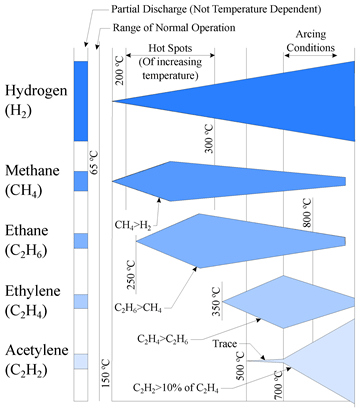
When electric companies think about monitoring transformer health, hydrogen detection often comes up first. It’s seen as the best way to catch problems early. But is hydrogen monitoring enough on its own? Or do you need to monitor more gases to get the full picture? This guide looks at the pros and cons of hydrogen-only monitoring versus checking multiple gases.
Hydrogen gas forms when transformers develop problems. It shows up early in the process, often before other warning signs appear. This makes it a great early warning system.
Here’s why hydrogen is special: it forms at almost all fault temperatures. As problems get worse and temperatures rise, more hydrogen gets created. Other gases come and go at different temperatures, but hydrogen keeps increasing.

Hydrogen often appears first when there’s a fault. This includes problems like corona discharge or small arcing events. Here’s what makes it useful:
The choice between hydrogen-only monitoring and multi-gas analysis comes down to how critical your transformer is and your budget.
Single-gas hydrogen monitors like the Serveron TM1 and Qualitrol DGA 150/250/400 series work great for:
The TM8 monitors 8 different gases online. It gives you much more detailed information for critical transformers through:
While hydrogen gives great early warnings, monitoring just one gas has limits you need to know about.
Studies show that when you use just one key gas to diagnose problems, you’ll get the wrong answer 30-50% of the time. This can lead to wrong decisions. Here’s what hydrogen monitoring alone can’t do:
Some transformer oils contain additives called passivators. These chemicals help protect the oil but can make hydrogen readings higher than normal. This means you might get false alarms if you don’t know your oil contains these additives.
Qualitrol offers different DGA solutions for different needs and budgets:
Serveron TM1: Watches hydrogen levels all the time. You can set it to alarm when levels get high or when they’re rising fast.
DGA 150/250/400 Series: These monitors go right in the transformer oil. They work with your existing monitoring equipment and are easy to install.
Serveron TM8: This is the top choice for critical transformers. It monitors 8 different gases with lab-quality accuracy.
Serveron TM3: Monitors 3 key gases and uses the proven Duval triangle method to identify specific fault types.
The choice between hydrogen-only and multi-gas monitoring depends on how critical your transformer is, your budget, and what you need to know.
Many companies use a layered approach. They put hydrogen monitors on most transformers for early warning, then use multi-gas systems on their most critical units.
Today’s monitoring platforms let you track data, get alerts, and review reports from anywhere. This gives you clear visibility into transformer health and failure risks.
Qualitrol also provides full installation services, training, and 24/7 monitoring support so you can access your transformer data from anywhere.
Successful monitoring programs usually include these key elements:
Hydrogen monitoring gives excellent early fault detection and is cost-effective for many transformer monitoring needs. However, if you manage critical transformers, you should consider multi-gas DGA systems for complete fault diagnosis and better reliability.
The best approach often uses both technologies: hydrogen monitors for broad fleet coverage and multi-gas analyzers for mission-critical transformers where you need to know exactly what’s wrong.
Hydrogen shows up in most fault conditions, so it gives excellent early warning. However, single-gas monitoring can’t tell you what specific type of fault you have or tell the difference between heat and electrical problems.
Consider multi-gas analysis for critical transformers where you need to identify specific fault types, or when hydrogen trends show developing problems that need detailed diagnosis.
Oil additives (especially passivators), transformer loading, outside temperature, and oil age can all influence hydrogen levels. Proper baseline testing and trend analysis help you tell normal changes from fault conditions.
Получите последние данные от Qualitrol Зарегистрируйтесь сейчас для получения специальных обновлений, предложений и рекламных акций.
Зарегистрируйтесь сейчас